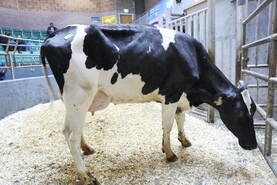Biogenic methane from ruminants is a potent greenhouse gas which is produced and released from methanogens in the rumen. It is a by-product of digestive microbial fermentation in the rumen.
The vast majority of ruminant methane research worldwide has been conducted under confinement systems, where animals are offered diets that are markedly different to grazing systems.
GreenFeed units
To gain a better understanding of the methane produced by grazing dairy cows, GreenFeed units (pictured) have been acquired to measure methane at grazing.
Cows are enticed to visit these units two to three times per day by offering a small amount of concentrate feed. When the cows enter the machine their breath is sampled, and is then measured for methane.
The impact of selecting cows using the Economic Breeding Index (EBI) on methane production is being evaluated using two groups of animals divergent for EBI within the Next Generation Herd; cows with a high EBI of €225 and cows with national average EBI of €130.

Katie Starsmore is a research technician measuring methane emissions in dairy cows and is based in Teagasc Moorepark. \ Donal O'Leary
Initial results indicate no difference in daily methane production per cow between the two groups, but the increased milk solids output of the high-EBI cows results in lower methane being produced per kg of milk solids output.
There is also variation for methane between individual cows within each genetic group, meaning it may be possible to select cows for lower methane production in the future.
Baseline values
The total amount of methane produced by dairy cows across a full grazing season is also being quantified to create baseline methane values for Irish grazing dairy cows.
The production of methane per cow increased by 35% between April (262 g/day) and August (355 g/day), while trends in milk yield went in the opposite direction.
The methane values measured during early lactation (March-May) were 23% lower than methane values predicted using national inventory methodology.
The measured methane is in agreement with the estimated values in mid lactation, while further data is being collected in the late lactation period.
Future research will identify the main factors responsible for the lower methane values in the spring period, and also examine the effect of white clover inclusion and the potential of feed supplements to enhance our methane mitigation strategies in grazing dairy systems.
Biogenic methane from ruminants is a potent greenhouse gas which is produced and released from methanogens in the rumen. It is a by-product of digestive microbial fermentation in the rumen.
The vast majority of ruminant methane research worldwide has been conducted under confinement systems, where animals are offered diets that are markedly different to grazing systems.
GreenFeed units
To gain a better understanding of the methane produced by grazing dairy cows, GreenFeed units (pictured) have been acquired to measure methane at grazing.
Cows are enticed to visit these units two to three times per day by offering a small amount of concentrate feed. When the cows enter the machine their breath is sampled, and is then measured for methane.
The impact of selecting cows using the Economic Breeding Index (EBI) on methane production is being evaluated using two groups of animals divergent for EBI within the Next Generation Herd; cows with a high EBI of €225 and cows with national average EBI of €130.

Katie Starsmore is a research technician measuring methane emissions in dairy cows and is based in Teagasc Moorepark. \ Donal O'Leary
Initial results indicate no difference in daily methane production per cow between the two groups, but the increased milk solids output of the high-EBI cows results in lower methane being produced per kg of milk solids output.
There is also variation for methane between individual cows within each genetic group, meaning it may be possible to select cows for lower methane production in the future.
Baseline values
The total amount of methane produced by dairy cows across a full grazing season is also being quantified to create baseline methane values for Irish grazing dairy cows.
The production of methane per cow increased by 35% between April (262 g/day) and August (355 g/day), while trends in milk yield went in the opposite direction.
The methane values measured during early lactation (March-May) were 23% lower than methane values predicted using national inventory methodology.
The measured methane is in agreement with the estimated values in mid lactation, while further data is being collected in the late lactation period.
Future research will identify the main factors responsible for the lower methane values in the spring period, and also examine the effect of white clover inclusion and the potential of feed supplements to enhance our methane mitigation strategies in grazing dairy systems.







 This is a subscriber-only article
This is a subscriber-only article










SHARING OPTIONS: